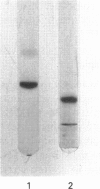Abstract
A single novel enzyme, glyoxalase III, which catalyses the conversion of methylglyoxal into D-lactate without involvement of GSH, has been detected in and purified from Escherichia coli. Of several carbonyl compounds tested, only the alpha-ketoaldehydes methylglyoxal and phenylglyoxal were found to be substrates for this enzyme. Glyoxalase III is active over a wide range of pH with no sharp pH optimum. In its native form it has an M(r) of 82000 +/- 2000, and it is composed of two subunits of equal M(r). Glutathione analogues, which are inhibitors of glyoxalase I, do not inhibit glyoxalase III. Glyoxalase III is found to be sensitive to thiol-blocking reagents. The p-hydroxymercuribenzoate-inactivated enzyme could be almost completely re-activated by dithiothreitol and other thiol-group-containing compounds, indicating the possible involvement of thiol group(s) at or near the active site of the enzyme.
Full text
PDF




Images in this article
Selected References
These references are in PubMed. This may not be the complete list of references from this article.
- Baldomà L., Aguilar J. Involvement of lactaldehyde dehydrogenase in several metabolic pathways of Escherichia coli K12. J Biol Chem. 1987 Oct 15;262(29):13991–13996. [PubMed] [Google Scholar]
- Brophy P. M., Crowley P., Barrett J. A novel NADPH/NADH-dependent aldehyde reduction enzyme isolated from the tapeworm Moniezia expansa. FEBS Lett. 1990 Apr 24;263(2):305–307. doi: 10.1016/0014-5793(90)81400-i. [DOI] [PubMed] [Google Scholar]
- Cooper R. A., Anderson A. The formation and catabolism of methylglyoxal during glycolysis in Escherichia coli. FEBS Lett. 1970 Dec 11;11(4):273–276. doi: 10.1016/0014-5793(70)80546-4. [DOI] [PubMed] [Google Scholar]
- Cooper R. A. Methylglyoxal synthase. Methods Enzymol. 1975;41:502–508. doi: 10.1016/s0076-6879(75)41106-5. [DOI] [PubMed] [Google Scholar]
- DAVIS B. J. DISC ELECTROPHORESIS. II. METHOD AND APPLICATION TO HUMAN SERUM PROTEINS. Ann N Y Acad Sci. 1964 Dec 28;121:404–427. doi: 10.1111/j.1749-6632.1964.tb14213.x. [DOI] [PubMed] [Google Scholar]
- Ekwall K., Mannervik B. Inhibition of yeast S-lactylglutathione lyase (glyoxalase I) by sulfhydryl reagents. Arch Biochem Biophys. 1970 Mar;137(1):128–132. doi: 10.1016/0003-9861(70)90419-4. [DOI] [PubMed] [Google Scholar]
- Freedberg W. B., Kistler W. S., Lin E. C. Lethal synthesis of methylglyoxal by Escherichia coli during unregulated glycerol metabolism. J Bacteriol. 1971 Oct;108(1):137–144. doi: 10.1128/jb.108.1.137-144.1971. [DOI] [PMC free article] [PubMed] [Google Scholar]
- LOWRY O. H., ROSEBROUGH N. J., FARR A. L., RANDALL R. J. Protein measurement with the Folin phenol reagent. J Biol Chem. 1951 Nov;193(1):265–275. [PubMed] [Google Scholar]
- Laemmli U. K. Cleavage of structural proteins during the assembly of the head of bacteriophage T4. Nature. 1970 Aug 15;227(5259):680–685. doi: 10.1038/227680a0. [DOI] [PubMed] [Google Scholar]
- Mannervik B., Aronsson A. C., Tibbelin G. Glyoxalase I from human erythrocytes. Methods Enzymol. 1982;90(Pt E):535–541. doi: 10.1016/s0076-6879(82)90181-1. [DOI] [PubMed] [Google Scholar]
- Mannervik B., Marmstål E., Ekwall K., Górna-Hall B. Inactivation of glyoxalase I from porcine erythrocytes and yeast by amino-group reagents. Eur J Biochem. 1975 May 6;53(2):327–333. doi: 10.1111/j.1432-1033.1975.tb04072.x. [DOI] [PubMed] [Google Scholar]
- Marmstål E., Aronsson A. C., Mannervik B. Comparison of glyoxalase I purified from yeast (Saccharomyces cerevisiae) with the enzyme from mammalian sources. Biochem J. 1979 Oct 1;183(1):23–30. doi: 10.1042/bj1830023. [DOI] [PMC free article] [PubMed] [Google Scholar]
- Murata K., Fukuda Y., Simosaka M., Watanabe K., Saikusa T., Kimura A. Metabolism of 2-oxoaldehyde in yeasts. Purification and characterization of NADPH-dependent methylglyoxal-reducing enzyme from Saccharomyces cerevisiae. Eur J Biochem. 1985 Sep 16;151(3):631–636. doi: 10.1111/j.1432-1033.1985.tb09151.x. [DOI] [PubMed] [Google Scholar]
- Murata K., Tani K., Kato J., Chibata I. Excretion of glutathione by methylglyoxal-resistant Escherichia coli. J Gen Microbiol. 1980 Oct;120(2):545–547. doi: 10.1099/00221287-120-2-545. [DOI] [PubMed] [Google Scholar]
- Oray B., Norton S. J. Glyoxalase II from mouse liver. Methods Enzymol. 1982;90(Pt E):547–551. doi: 10.1016/s0076-6879(82)90183-5. [DOI] [PubMed] [Google Scholar]
- RACKER E. The mechanism of action of glyoxalase. J Biol Chem. 1951 Jun;190(2):685–696. [PubMed] [Google Scholar]
- Ray M., Ray S. Purification and partial characterization of a methylglyoxal reductase from goat liver. Biochim Biophys Acta. 1984 Nov 6;802(1):119–127. doi: 10.1016/0304-4165(84)90041-2. [DOI] [PubMed] [Google Scholar]
- Ray S., Ray M. Purification and characterization of NAD and NADP-linked alpha-ketoaldehyde dehydrogenases involved in catalyzing the oxidation of methylglyoxal to pyruvate. J Biol Chem. 1982 Sep 25;257(18):10566–10570. [PubMed] [Google Scholar]
- Rhee H., Murata K., Kimura A. Purification and characterization of glyoxalase I from Pseudomonas putida. Biochem Biophys Res Commun. 1986 Dec 30;141(3):993–999. doi: 10.1016/s0006-291x(86)80142-5. [DOI] [PubMed] [Google Scholar]
- Schasteen C. S., Reed D. J. Involvement of arginine residues in glutathione binding to yeast glyoxalase I. Biochim Biophys Acta. 1983 Jan 26;742(2):419–425. doi: 10.1016/0167-4838(83)90329-1. [DOI] [PubMed] [Google Scholar]
- Still J. L. Glyoxalase of Bacterium coli. Biochem J. 1941 Mar;35(3):390–391. doi: 10.1042/bj0350390. [DOI] [PMC free article] [PubMed] [Google Scholar]
- Thornalley P. J. The glyoxalase system: new developments towards functional characterization of a metabolic pathway fundamental to biological life. Biochem J. 1990 Jul 1;269(1):1–11. doi: 10.1042/bj2690001. [DOI] [PMC free article] [PubMed] [Google Scholar]
- Vince R., Daluge S., Wadd W. B. Studies on the inhibition of glyoxalase I by S-substituted glutathiones. J Med Chem. 1971 May;14(5):402–404. doi: 10.1021/jm00287a006. [DOI] [PubMed] [Google Scholar]
- Vince R., Wadd W. B. Glyoxalase inhibitors as potential anticancer agents. Biochem Biophys Res Commun. 1969 Jun 6;35(5):593–598. doi: 10.1016/0006-291x(69)90445-8. [DOI] [PubMed] [Google Scholar]



